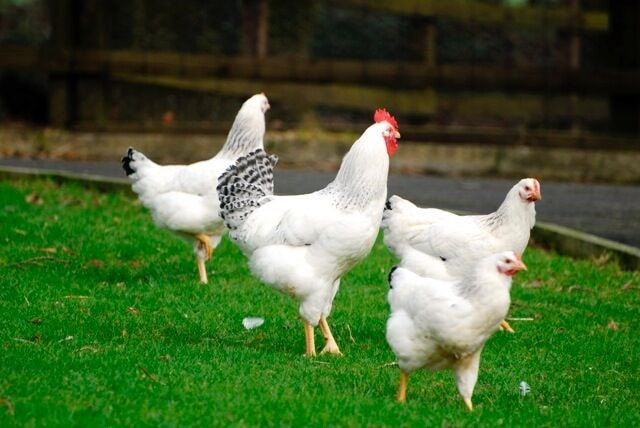Delawares were first developed in 1940 from off-coloured sports which occurred from a cross between Barred Plymouth Rock males and New Hampshire females. They are named after the state in which they originated. They lacked the black extension factor that would normally have been transmitted from the barred Plymouth Rock male with the result that they became almost white, showing a slight indication of barring in the hackles, primaries, secondaries and tail. Accepted as a standard breed in USA in 1952. A vigorous dual purpose bird with well-developed egg and meat characteristics.
General characteristics: male
Carriage: Erect and graceful, denoting an active fowl.
Type: Body broad, full, compact. Back moderately long, nearly horizontal, broad its entire length, forming a gradual concave sweep from the saddle to tail. Breast deep, full, broad and well rounded. Wings moderately large, well folded, carried close to body, lower line of folded wing carried horizontally. Primaries and Secondaries broad and overlapping in natural order when wings folded. Main tail broad and overlapping, of medium length, well spread, carried at an angle of 40 degrees above horizontal. Sickles medium length, extending beyond main tail, coverts medium length, broad.
Head: Medium size, moderately deep, inclined to be flat on top. Beak strong, medium in length, regularly curved. Face surface smooth, full in front of eyes, skin fine and soft in texture. Eyes large, full and prominent. Comb single, moderately large, well developed set firmly on the head, perfectly straight and having five well defined points, those in front and rear smaller than those in the centre; blade smooth, inclining slightly downward, not following contour of neck too closely. Earlobes elongated oval, of medium size, fitting close to head. Wattles moderately long, uniform, smooth, fine in texture, free from folds or wrinkles.
Neck: Medium length, well-arched, tapering. Hackle well developed, flowing over shoulders, moderately close feathered.
Legs and feet: set well apart, straight when viewed from in front. Lower thighs large, muscular, well feathered. Shanks medium length, smooth, fine, free from feathers. Toes four, well spread.
Plumage: Feathering soft but close. Body fluff moderately full.
Female
The general characteristics are similar to those of the male, allowing for the natural sexual differences.
General characteristics: male
Carriage: Erect and graceful, denoting an active fowl.
Type: Body broad, full, compact. Back moderately long, nearly horizontal, broad its entire length, forming a gradual concave sweep from the saddle to tail. Breast deep, full, broad and well rounded. Wings moderately large, well folded, carried close to body, lower line of folded wing carried horizontally. Primaries and Secondaries broad and overlapping in natural order when wings folded. Main tail broad and overlapping, of medium length, well spread, carried at an angle of 40 degrees above horizontal. Sickles medium length, extending beyond main tail, coverts medium length, broad.
Head: Medium size, moderately deep, inclined to be flat on top. Beak strong, medium in length, regularly curved. Face surface smooth, full in front of eyes, skin fine and soft in texture. Eyes large, full and prominent. Comb single, moderately large, well developed set firmly on the head, perfectly straight and having five well defined points, those in front and rear smaller than those in the centre; blade smooth, inclining slightly downward, not following contour of neck too closely. Earlobes elongated oval, of medium size, fitting close to head. Wattles moderately long, uniform, smooth, fine in texture, free from folds or wrinkles.
Neck: Medium length, well-arched, tapering. Hackle well developed, flowing over shoulders, moderately close feathered.
Legs and feet: set well apart, straight when viewed from in front. Lower thighs large, muscular, well feathered. Shanks medium length, smooth, fine, free from feathers. Toes four, well spread.
Plumage: Feathering soft but close. Body fluff moderately full.
Female
The general characteristics are similar to those of the male, allowing for the natural sexual differences.
Please contact the breed registrar for more information


